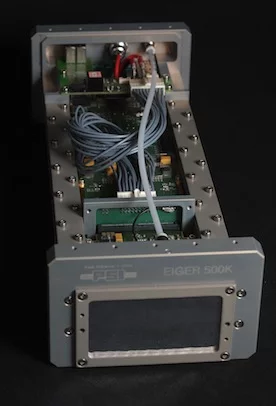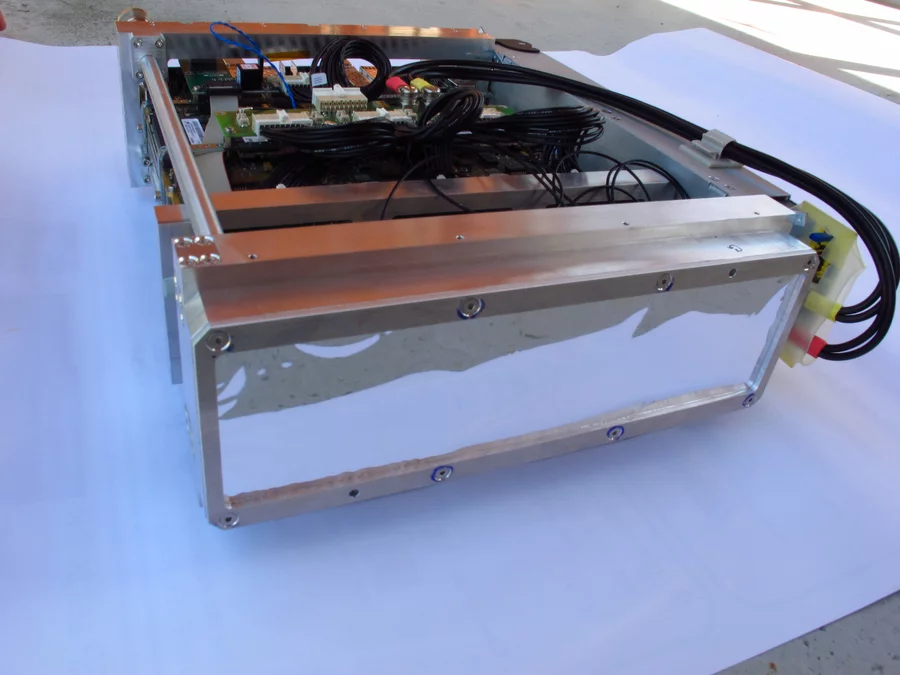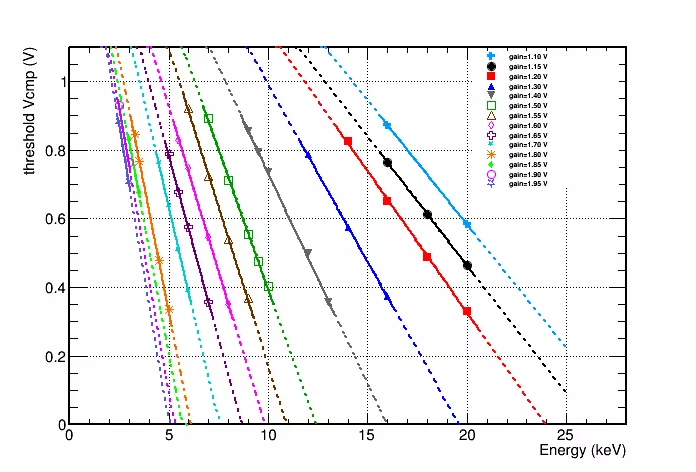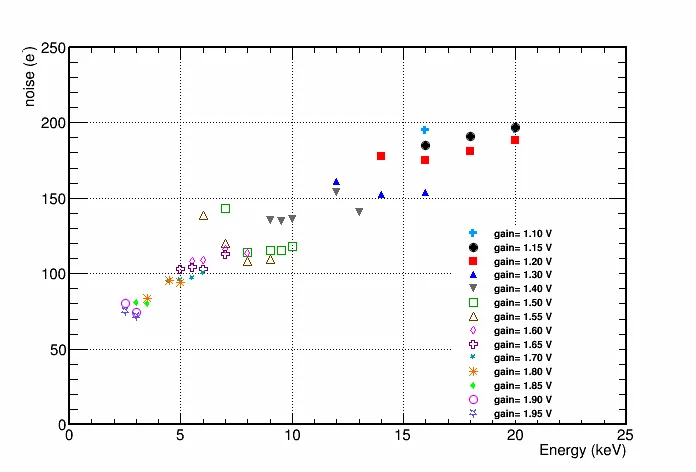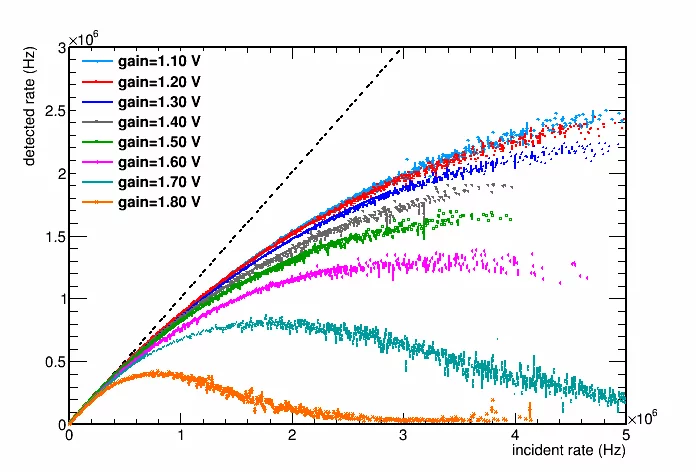EIGER is a Single-Photon Counting (SPC) pixel detector developed at the Paul Scherrer Institut, tailored for synchrotron applications. In SPCs, the counter of a pixel increments by one when a photon interaction generates a signal that surpasses a predetermined threshold. This adjustable threshold allows background rejection, improving the sensitivity to the signals of interest. EIGER's working principle is similar to the PILATUS detector, with 5 times more pixels per unit area and a frame rate up to 100 times faster.
Detector description
The Detector Group at PSI has developed multiple EIGER systems for synchrotron applications. Each EIGER module consists of 500 kPixels (75x75 µm²) with an 8x4 cm² sensitive area and is equipped with 6 FPGAs for onboard intelligence, enabling frame storage and count rate corrections before data transfer via Ethernet. These modules function as building blocks for larger systems that operate in fully parallel mode for acquisition, readout, and data transfer, with the system frame rate independent from the detector size. Notably, a 1.5M system is operational at the cSAXS beamline for wide-angle scattering, while the largest EIGER to date, a 9M system, serves small-angle scattering.
Detector characteristics
- Pixel size 75x75 µm2
- Noise: depending on settings, 70-200 e- (250-700 eV)
- Sensitive to energies > 2.5 keV
- Pixel to pixel threshold inhomogeneities: 70-150 eV
- Counter depth: configurable in 4/8/12 bit mode.
- Summing frames on board allows 32 bit depth counter
- Continuous applications possible: 4 µs dead time between frames.
- Frame rate: up to
- 23 kHz in 4 bit, burst mode,
- 7 kHz in 12 bit, burst mode
- 2 kHz continuous, 12 bit, 10 Gb Ethernet
- 250 Hz continuous, 12 bit, 1 Gb Ethernet
- Count rate capabilities: 0.2-0.7 MHz/pixel @ 90% linearity
Applications
- Coherent diffractive imaging (CDI) and ptychography
- Small Angle X-ray Scattering (SAXs)
- Protein Crystallography (PX)
- X-ray Photon Correlation Spectroscopy (XPCS)
Results showing the performance of EIGER in ptychography can be found here.
Perfomances
Documentation
Publications
-
Butcher TA, Phillips NW, Chiu CC, Wei CC, Ho SZ, Chen YC, et al.
Ptychographic nanoscale imaging of the magnetoelectric coupling in freestanding BiFeO3
Advanced Materials. 2024; 36(23): 2311157 (6 pp.). https://doi.org/10.1002/adma.202311157
DORA PSI -
Fröjdh E, Bergamaschi A, Schmitt B
Single-photon counting detectors for diffraction-limited light sources
Frontiers in Physics. 2024; 12: 1304896 (11 pp.). https://doi.org/10.3389/fphy.2024.1304896
DORA PSI -
Tinti G, Fröjdh E, van Genderen E, Gruene T, Schmitt B, de Winter DAM, et al.
Electron crystallography with the EIGER detector
IUCrJ. 2018; 5(2): 190-199. https://doi.org/10.1107/S2052252518000945
DORA PSI -
Zinn T, Homs A, Sharpnack L, Tinti G, Fröjdh E, Douissard P-A, et al.
Ultra-small-angle X-ray photon correlation spectroscopy using the Eiger detector
Journal of Synchrotron Radiation. 2018; 25(6): 1753-1759. https://doi.org/10.1107/S1600577518013899
DORA PSI -
Tinti G, Marchetto H, Vaz CAF, Kleibert A, Andrä M, Barten R, et al.
The EIGER detector for low-energy electron microscopy and photoemission electron microscopy
Journal of Synchrotron Radiation. 2017; 24(5): 963-974. https://doi.org/10.1107/S1600577517009109
DORA PSI -
Tinti G, Bergamaschi A, Cartier S, Dinapoli R, Greiffenberg D, Johnson I, et al.
Performance of the EIGER single photon counting detector
Journal of Instrumentation. 2015; 10(3): C03011 (8 pp.). https://doi.org/10.1088/1748-0221/10/03/C03011
DORA PSI -
Tinti G, Bergamaschi A, Cartier S, Dinapoli R, Greiffenberg D, Horisberger R, et al.
Similarities and differences of recent hybrid pixel detectors for X-ray and high energy physics developed at the Paul Scherrer Institut
Journal of Instrumentation. 2015; 10: C04043 (7 pp.). https://doi.org/10.1088/1748-0221/10/04/C04043
DORA PSI -
Guizar-Sicairos M, Johnson I, Diaz A, Holler M, Karvinen P, Stadler H-C, et al.
High-throughput ptychography using Eiger: scanning X-ray nano-imaging of extended regions
Optics Express. 2014; 22(12): 14859-14870. https://doi.org/10.1364/OE.22.014859
DORA PSI -
Johnson I, Bergamaschi A, Billich H, Cartier S, Dinapoli R, Greiffenberg D, et al.
Eiger: a single-photon counting x-ray detector
Journal of Instrumentation. 2014; 9(5): C05032 (8 pp.). https://doi.org/10.1088/1748-0221/9/05/C05032
DORA PSI -
Dinapoli R, Bergamaschi A, Greiffenberg D, Henrich B, Horisberger R, Johnson I, et al.
EIGER characterization results
Nuclear Instruments and Methods in Physics Research, Section A: Accelerators, Spectrometers, Detectors and Associated Equipment. 2013; 731: 68-73. https://doi.org/10.1016/j.nima.2013.04.047
DORA PSI -
Johnson I, Bergamaschi A, Buitenhuis J, Dinapoli R, Greiffenberg D, Henrich B, et al.
Capturing dynamics with Eiger, a fast-framing X-ray detector
Journal of Synchrotron Radiation. 2012; 19(6): 1001-1005. https://doi.org/10.1107/S0909049512035972
DORA PSI -
Radicci V, Bergamaschi A, Dinapoli R, Greiffenberg D, Henrich B, Johnson I, et al.
EIGER a new single photon counting detector for X-ray applications: performance of the chip
Journal of Instrumentation. 2012; 7(2): C02019 (10 pp.). https://doi.org/10.1088/1748-0221/7/02/C02019
DORA PSI -
Dinapoli R, Bergamaschi A, Henrich B, Horisberger R, Johnson I, Mozzanica A, et al.
EIGER: Next generation single photon counting detector for X-ray applications
Nuclear Instruments and Methods in Physics Research, Section A: Accelerators, Spectrometers, Detectors and Associated Equipment. 2011; 650(1): 79-83. https://doi.org/10.1016/j.nima.2010.12.005
DORA PSI -
Lehmann EH, Tremsin A, Grünzweig C, Johnson I, Boillat P, Josic L
Neutron imaging - detector options in progress
Journal of Instrumentation. 2011; 6(1): C01050 (15 pp.). https://doi.org/10.1088/1748-0221/6/01/C01050
DORA PSI
Team
| Person | Position | Phone Nr. | |
|---|---|---|---|
| Dr. Lars Erik Fröjd | Scientist
|



